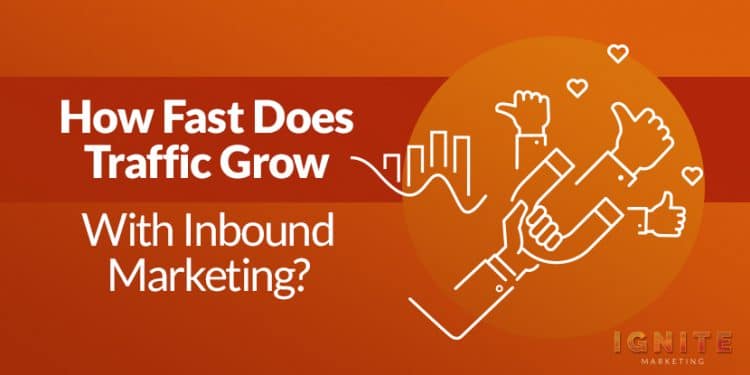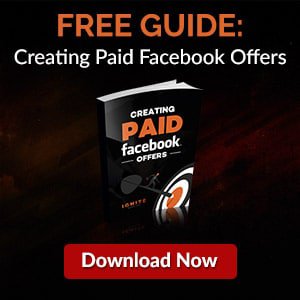


Website traffic is one of the biggest indicators that your marketing efforts are succeeding. But if you do not see the traffic numbers you like, you might be wondering how long it will take before your inbound efforts pay off.
So, how fast does traffic grow with inbound marketing? The speed at which your traffic grows with inbound marketing depends on several factors:
The success of any business nowadays is heavily dependent on their inbound marketing efforts including effective PPC campaigns. To help you gauge the rate at which traffic brought in by inbound marketing should grow, read on.

In inbound marketing, content is king. It’s the lifeblood that drives your entire inbound machine.
Without a decent amount of high-quality content, you won’t have any useful or educational material to use for attracting prospects. And if you can’t attract prospects, you can’t grow your website traffic.
It’s not just about creating a bunch of content quickly, though.
Gone are the days where spammy blackhat SEO techniques can push a sub-par batch of articles to the top of the search results. If you want to rank now, you need to put out genuinely useful content that helps readers solve a problem.
Both the quality of content and the amount of content you have will impact your traffic growth rate.
Taking the time to write genuinely helpful content will drive traffic to your website in several ways:
If you’re going to put effort into any single thing mentioned in this article, it should be content quality. Releasing one highly informative and well-researched blog post per month will likely drive more traffic than 30 half-baked pieces with little to no research.
Great content is super important. But how do you differentiate it from sub-par content?
Here are few telltale signs a piece of content is exceptional:

Knowing how to identify exceptional content is essential.
But how do you write it?
I could write a thousand articles on how to create great content. And if I did, I still wouldn’t have covered everything.
However, some advice is better than none. Here are some essential elements of a great piece of content:
Creating great content should be your top priority. But once you’ve figured out how to make it, you should figure out how to make a lot of it.
Making more content will increase your rate of traffic growth in the following ways:

This next section will discuss the channels on which you can place your content and drive traffic to your website.
By building and optimizing your presence on each of these channels, you can leverage the terrific content you’ve spent tons of time (or money) creating and exponentially increase your traffic growth rate.
The most direct and hands-off way to attract traffic with inbound marketing is through organic search results. By tailoring your content to specific queries on Google, you can rank in the top search result slots and get a consistent source of lucrative, free, and highly motivated traffic.
Pay-Per-Click (PPC) ads are the ads that show up in the search engine results. If you have a competitive and profitable keyword you’d like to target, you can write content geared toward that keyword and leapfrog all of the organic results with PPC search ads.
PPC ads used to be considered a form of outbound marketing, but the industry has changed its tune in recent years. As such, PPC ads are now an essential component of any comprehensive inbound marketing strategy.
Organic social media marketing consists of building and interacting with your followers. The more active and engaged social media followers you have clicking on the content you share, the more traffic you’ll be able to drive to your website.
Your email list is an excellent source of website traffic. By sharing new content with your email subscribers, you can significantly increase the reach of your content.
While your email list probably won’t bring in the highest numbers of raw traffic, it will bring in some of the most interested and motivated visitors.
And remember that new content doesn’t always mean you have to write something ‘new’… you can re-purpose some of your greatest blogs, podcasts, etc. by re-writing or re-positioning them in an email.
This is a useful and effective way to get more out of the great content you’ve already published.

The last factor impacting how quickly you can grow traffic with inbound marketing is your budget.
At the start of their marketing journey, many business owners begin with a marketing budget of $0. They don’t know if this inbound marketing stuff will work for them, and they’re understandably hesitant to invest any serious money. So they make their own content, bootstrap a website, and build up their channels through organic methods.
Making content and building organic traffic sources will always be useful. However, your time is limited.
You’re only one person, with two sets of hands and sixteen hours to use per day. Maybe a little more if you sacrifice sleep.
If you want to scale up your inbound marketing efforts and increase your traffic growth rate, you’ll need to spend some money.
Now, I’m not saying that throwing money at marketing will magically bring in truckloads of traffic. If you don’t carefully test what you’re doing, you could spend a lot on relatively little results.
But a smart application of funds will be more helpful than not using those funds at all.
Here are the ways a larger inbound marketing budget can grow your traffic:
